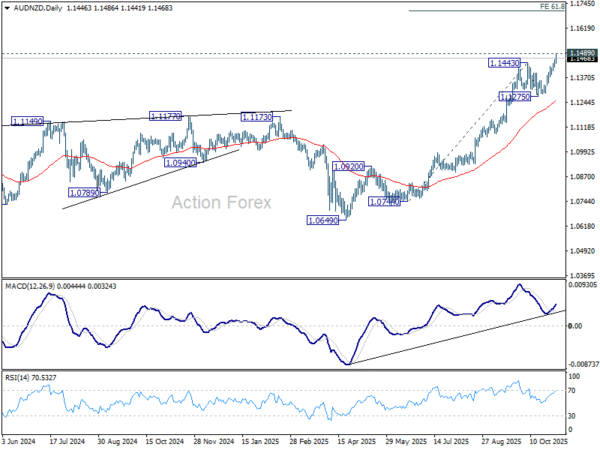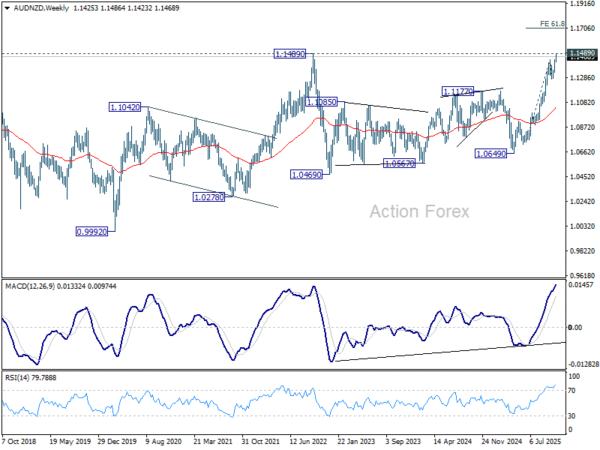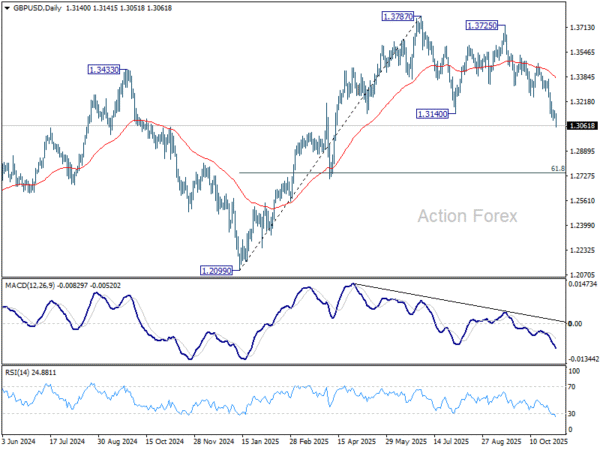Risk-Off Tone Lifts Yen, Dollar; Kiwi Soft Before Jobs Report – Action Forex
Global markets traded with a mild risk-off tone today as investors favored defensive plays. With no major data releases scheduled, sentiment rather than fundamentals set the tone, pushing the Japanese Yen to the top of the performance board while the Australian and New Zealand Dollars lagged.
Yen’s strength was also supported by another round of verbal intervention from Japanese authorities. Finance Minister Satsuki Katayama reiterated her “strong sense of urgency” over recent currency moves, warning against excessive speculation. Still, USD/JPY’s pullback was modest, as most analysts — including Goldman Sachs and Bank of America — agreed that 155 is not a trigger level for direct action. Tokyo appears focused on smoothing volatility rather than defending any particular line in the sand.
Meanwhile, the Dollar retained its underlying bid as markets continued to scale back expectations for a December Fed rate cut. A string of firm comments from policymakers has kept investors wary of prematurely pricing in easing. That backdrop makes it difficult for Japan to counter Dollar strength through intervention alone — a view echoed by traders who believe officials are more likely to talk than act for now.
In contrast, Aussie and Kiwi remained under pressure amid the softer risk tone. The Kiwi was weaker still, with traders wary ahead of key New Zealand labor data that could validate expectations for another RBNZ rate cut later this month.
Across the week so far, Yen is currently the top performer, followed by Dollar and Euro. Kiwi, Aussie, and Pound are at the bottom. Euro and Franc are mid-pack.
In Europe, at the time of writing, FTSE is down -0.44%. DAX is down -1.21%. CAC is down -1.12%. UK 10-year yield is down -0.019 at 4.423. Germany 10-year yield is down -0.011 at 2.658. Earlier in Asia, Nikkei fell -1.74%. Hong Kong HSI fell -0.79%. China Shanghai SSE fell -0.41%. Singapore Strait Times fell -0.49%. Japan 10-year JGB yield rose 0.018 to 1.676.
SNB’s Tschudin: No need for negative rates, comfortable with outlook
The SNB appears comfortable maintaining its stance after board member Petra Tschudin said current interest rates are appropriate given Switzerland’s inflation outlook. In an interview with TeleZueri, she noted that the SNB’s forecasts place inflation between 0% and 2% over the medium term, consistent with its definition of price stability.
“From that perspective, interest rates are where they should be,” she said, adding that the central bank’s stance remains well calibrated to current conditions. Tschudin’s remarks were interpreted as a signal that the SNB will keep its policy rate at 0% for the foreseeable future.
Tschudin acknowledged that global conditions are shifting quickly but said there is no justification for reintroducing negative rates. “The central bank would only deploy negative rates if necessary,” she said, “but with the current inflation forecasts there is no need.”
Elsewhere, Chairman Martin Schlegel reiterated that Swiss inflation should edge slightly higher in the next few quarters, though global growth remains pressured by U.S. tariff actions.
RBA holds at 3.60%, upgrades inflation path, sees only one cut in 2026
The RBA kept the cash rate unchanged at 3.60%, a move widely expected by markets and decided unanimously by the Board. In the statement, policymakers said the decision reflected a balance between inflation risks and economic resilience, noting that Q3 CPI was “materially higher” than expected and that there was “recent evidence of more persistent inflation.” Together with signs of recovering private demand and a labor market that remains “a little tight,” the Bank judged that current settings remain appropriate.
The updated economic projections painted a picture of stickier inflation but slightly better near-term growth. Average GDP growth for 2025 was upgraded from 1.6% to 1.8%, while the 2026 projection was trimmed from 2.1% to 1.9%, and 2027 was kept unchanged at 2.0%.
Headline inflation forecasts were lifted across the board — from 3.0% to 3.3% for the end of 2025, 2.9% to 3.2% for 2026, and 2.5% to 2.6% for 2027 — reflecting persistent price pressures in both goods and services.
Underlying inflation was also revised higher. The trimmed mean CPI forecast jumped from 2.6% to 3.2% by the end of 2025, while the 2026 estimate edged up from 2.6% to 2.7%, and 2027 from 2.5% to 2.6%.
These upward revisions highlight the Bank’s view that inflation will take longer to return sustainably to target.
Meanwhile, policy-rate assumptions in the central scenario indicate no further rate cuts in 2025, followed by just over one reduction next year, lowering the cash rate to around 3.3% by the end of 2026, where it is expected to remain through 2027.
Japan’s PMI manufacturing finalized at 48.2, but sentiment shows improvement
Japan’s manufacturing sector contracted again in October, with the final S&P Global PMI edging down to 48.2 from 48.5 in September. According to S&P Global’s Pollyanna De Lima, demand softness — particularly in the automotive and semiconductor sectors — triggered the sharpest fall in new orders since early 2024, while exports to Asia, Europe, and the U.S. continued to decline.
Manufacturers also faced rising cost pressures, as higher input costs squeezed margins even as demand waned. To offset these pressures, many firms lifted selling prices despite intense competition for new business.
Still, sentiment showed some improvement. The decline in production was relatively contained, and many firms expressed greater optimism about future output. Hopes for successful new product launches and expectations that the impact of U.S. tariffs will eventually fade helped boost confidence.
Kiwi slumps ahead of Q3 jobs data, AUD/NZD tests 2022 high
New Zealand Dollar is under broad pressure today, partly as risk sentiment turned mildly sour in Asian trade and extended into the European morning. The move reflected a combination of modest risk aversion and steady cross-selling against Australian Dollar, which found relative support following the RBA’s policy decision earlier in the day.
Even though Aussie was weighed down by the softer risk tone, it held firm against Kiwi after the RBA left the cash rate unchanged and signaled no further rate cuts this year, and likely only one more in 2026. In contrast, the OIS market continues to fully price a 25-basis-point cut by the RBNZ at its next meeting on November 26, with around a 50% chance of one final cut by mid-2026.
This policy divergence makes Wednesday’s New Zealand labor market report a potential flashpoint for further moves. Consensus forecasts point to only 0.1% employment growth in Q3 and an unemployment rate rising to 5.3%. Any downside surprise could tip the economy into two consecutive cycle of job losses, reinforcing, which would solidify the case for additional RBNZ rate cuts next year.
Technically, AUD/NZD is testing the 1.1489 resistance, its highest level since 2022. A decisive break above this zone would confirm bullish continuation and open the way toward the 61.8% projection of 1.0744 to 1.1443 from 1.1275 at 1.1707.
GBP/USD Mid-Day Outlook
Daily Pivots: (S1) 1.3111; (P) 1.3137; (R1) 1.3164; More…
Intraday bias in GBP/USD remains on the downside for the moment. Current fall from 1.3787 should now target 61.8% retracement of 1.2099 to 1.3787 at 1.2744 next. Sustained break there will pave the way to 1.2099 support next. On the upside, above 1.3161 minor resistance will turn intraday bias neutral first. But risk will stay on the downside as long as 1.3247 support turned resistance holds, in case of recovery.
In the bigger picture, rise from 1.0351 (2022 low) is still seen as a corrective move. Sustained trading below 55 W EMA (now at 1.3185) will argue that a medium term top has already formed and bring deeper fall back to 1.2099. Firm break there will confirm bearish reversal. In case of another rise, strong resistance should emerge below 1.4248 (2021 high) to cap upside.




